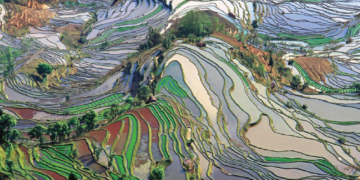Duhkha
1) What is Duhkha?
Duhkha, a concept rooted in ancient Indian philosophy, is a Sanskrit term often translated as “suffering” or “pain.” However, it encompasses a much broader and profound meaning than its simple English counterparts. Duhkha refers to the fundamental dissatisfaction or unsatisfactoriness inherent in the human condition. It recognizes that life is characterised by various forms of suffering and discontentment, both physical and mental, which are an integral part of existence.
Duhkha is a concept central to Buddhist teachings, where it is regarded as one of the Four Noble Truths. It acknowledges that suffering is an inherent part of human life and that our craving, attachment, and ignorance perpetuate this suffering. In Buddhist philosophy, Duhkha is not limited to physical pain but encompasses a wide range of experiences, including emotional anguish, dissatisfaction, frustration, and the existential sense of unease or dissatisfaction that pervades human existence.
Within the broader concept of Duhkha, different types of suffering are recognized. These include physical suffering, such as pain, illness, and bodily discomfort, which are evident to our senses. Emotional suffering arises from mental states like grief, fear, anxiety, depression, and the constant fluctuation of our emotional experiences. Existential suffering, on the other hand, encompasses the inherent dissatisfaction and restlessness that arises from our fundamental ignorance of the true nature of reality.
Another type of Duhkha is known as “samsaric suffering,” which refers to the cyclical nature of existence. According to Buddhist philosophy, we are trapped in an endless cycle of birth, death, and rebirth, known as samsara, and this perpetual cycle brings with it various forms of suffering. The experience of Duhkha arises from our inability to find lasting satisfaction and fulfilment within this cycle, as everything is impermanent and subject to change.
It is important to note that Duhkha is not meant to be a pessimistic view of life, but rather a realistic acknowledgement of the challenges and difficulties inherent in the human condition. By understanding the nature of Duhkha and its causes, according to Buddhist teachings, one can cultivate the path to liberation and transcendence from suffering, ultimately attaining a state of lasting peace and contentment known as Nirvana.
2) Dukkha-dukkha
Dukkha-dukkha refers to the type of suffering that arises from physical pain and discomfort. It is the most apparent and tangible form of suffering, arising from the inevitable experiences of illness, injury, ageing, and the general fragility of the human body. From a Buddhist perspective, this type of suffering reminds us of the impermanent and vulnerable nature of our existence.
Physical pain is a universal human experience, and it can range from mild discomfort to intense agony. It encompasses sensations such as bodily injuries, chronic illnesses, diseases, and the limitations imposed by our physical condition. Regardless of one’s social status, wealth, or personal achievements, everyone is susceptible to physical suffering. Dukkha-dukkha reminds us that our bodies are subject to decay, and no amount of material possessions or external factors can shield us from the physical pain and vulnerability inherent in being human.
Moreover, Dukkha-dukkha also extends beyond physical pain to encompass the suffering that arises from the constant pursuit of sensory pleasure. In our relentless quest for gratification and sensory stimulation, we often experience frustration, dissatisfaction, and the ephemeral nature of pleasure itself. The pleasure derived from external sources is transient, leading to a cycle of desire, attachment, and ultimately disappointment.
Buddhist teachings emphasise that clinging to physical pleasure as a source of happiness can perpetuate suffering. The fleeting nature of sensory pleasure and the constant striving to maintain or replicate it create an ongoing cycle of craving and attachment. By recognizing the inherent suffering in the pursuit of pleasure, one can develop a deeper understanding of the transient nature of these experiences and seek alternative paths towards lasting contentment and liberation.
3) Viparinama-dukkha
Viparinama-dukkha refers to the suffering that arises from the impermanence and constant change inherent in all phenomena. It is the suffering that stems from the inability of things and experiences to provide lasting satisfaction and stability. This type of dukkha highlights the transient nature of existence and the dissatisfaction that arises when we cling to what is inherently subject to change.
According to Buddhist philosophy, everything in the world is characterised by impermanence (anicca). Whether it is our physical bodies, relationships, material possessions, or even our thoughts and emotions, everything is in a state of constant flux. We often cling to these impermanent aspects of our lives, seeking stability and security in them. However, due to their ever-changing nature, they are incapable of providing lasting fulfilment.
Viparinama-dukkha manifests in various ways. For instance, it can be seen in the experience of loss and separation. Relationships, for example, can bring joy and happiness, but they are subject to change and eventually come to an end through various circumstances such as death, distance, or shifting dynamics. This impermanence gives rise to a sense of grief, loneliness, and the pain of separation.
Similarly, the impermanence of material possessions can lead to dissatisfaction. We may acquire objects that bring temporary pleasure or a sense of accomplishment, but over time they may lose their allure, break, or become obsolete. The attachment to these objects can generate frustration and disappointment, highlighting the inherent unsatisfactoriness of relying on external possessions for lasting happiness.
Viparinama-dukkha also extends to the realm of mental experiences. Our thoughts, emotions, and mental states are ever-changing. Happiness gives way to sadness, excitement fades into boredom, and calmness can be disrupted by anxiety. This constant fluctuation of our inner landscape can create a sense of restlessness and dissatisfaction, as we yearn for stability and emotional well-being.
Recognizing the presence of Viparinama-dukkha invites us to cultivate a deeper understanding of the impermanent nature of all things. Instead of attaching ourselves to fleeting phenomena, we are encouraged to develop equanimity, acceptance, and non-attachment. By embracing impermanence and understanding that change is an inherent part of life, we can find greater peace and freedom from the suffering that arises from clinging to what is ultimately transient.
By transcending Viparinama-dukkha, one can cultivate a sense of inner stability and contentment that is not reliant on external conditions. This requires a shift in perspective and a deepening of wisdom, allowing us to navigate the ever-changing nature of existence with greater resilience, acceptance, and compassion towards ourselves and others.
4) Sankhara-dukkha
Sankhara-dukkha refers to the suffering that arises from the conditioned and unstable nature of all mental and physical formations. It is the suffering that stems from the constant arising and passing away of thoughts, emotions, perceptions, and all other conditioned phenomena. This type of dukkha highlights the inherent unsatisfactoriness of clinging to or identifying with these transient aspects of our experience.
In Buddhist teachings, sankhara-dukkha is rooted in the concept of anatta, or not-self. It recognizes that all mental and physical formations, including our thoughts, emotions, and the body itself, are impermanent and lacking a fixed, independent self. They arise due to various causes and conditions and undergo constant change and dissolution.
This type of suffering can manifest in different ways. For example, it can be observed in the impermanent and ever-changing nature of our thoughts and emotions. Our minds are subject to incessant activity, constantly producing thoughts, judgments, and reactions. We may identify with certain thoughts or emotions, seeking to hold onto them or push them away. However, these mental formations are transient and unstable, leading to a sense of frustration, confusion, and dissatisfaction.
Sankhara-dukkha can also be seen in the impermanence and conditioned nature of the physical body. The body undergoes continuous transformation, ageing, and eventually, it will face decay and death. Despite our efforts to maintain its youthful appearance or prolong its lifespan, the body is subject to the laws of impermanence. The identification with the body and the attachment to its appearance can lead to a sense of insecurity, anxiety, and suffering.
Furthermore, sankhara-dukkha arises from the craving and clinging to these conditioned phenomena. We often develop attachments and aversions towards our experiences, seeking to hold onto what is pleasant and avoid what is unpleasant. However, this constant grasping and resistance create a perpetual cycle of desire, dissatisfaction, and suffering.
The recognition of sankhara-dukkha invites us to investigate the nature of our experiences and develop a deeper understanding of their impermanence and non-self nature. By cultivating mindfulness and insight, we can observe the arising and passing away of thoughts, emotions, and physical sensations without clinging to or identifying with them. This shift in perspective allows us to find freedom from the suffering that arises from attachment and aversion, leading to a greater sense of peace and liberation.
Ultimately, the path to transcend sankhara-dukkha involves developing wisdom, compassion, and non-attachment. By understanding and accepting the conditioned nature of all phenomena, we can cultivate a more profound and lasting sense of well-being that is not dependent on transient experiences or external conditions.
5) Its importance in understanding existence
The understanding of Duhkha, including its various types such as Dukkha-dukkha, Viparinama-dukkha, and Sankhara-dukkha, is of profound importance in comprehending the nature of existence and the human condition. It provides insights that can guide individuals towards a deeper understanding of reality and offer pathways to alleviate suffering.
Firstly, recognizing the existence of Duhkha serves as a powerful reminder of the impermanence and unsatisfactoriness that permeate our lives. It challenges the illusion of a perfect and permanent state of happiness, reminding us that the pursuit of pleasure and avoidance of pain alone cannot lead to lasting fulfilment. This understanding helps us avoid unrealistic expectations and delusions that may contribute to further suffering.
Furthermore, Duhkha invites us to question the nature of attachment and craving. By understanding the root causes of suffering, we can begin to examine the patterns of desire and clinging that bind us to a perpetual cycle of dissatisfaction. This awareness opens the possibility for cultivating non-attachment, letting go, and finding freedom from the endless pursuit of external sources of happiness.
The understanding of Duhkha also encourages self-reflection and introspection. It invites individuals to explore the nature of their own suffering and the sources from which it arises. By examining the different types of Duhkha, we can gain insights into our own experiences of physical and emotional pain, the transient nature of pleasure, and the conditioned nature of our thoughts and perceptions. This self-inquiry can lead to greater self-awareness, personal growth, and a more authentic and compassionate way of relating to ourselves and others.
Moreover, Duhkha serves as a catalyst for spiritual and philosophical inquiry. It raises fundamental existential questions about the nature of reality, the purpose of life, and the possibility of liberation from suffering. In traditions such as Buddhism, the understanding of Duhkha is a foundational element for embarking on the path towards enlightenment or awakening. By acknowledging and investigating Duhkha, individuals can develop a deeper understanding of the true nature of existence and engage in practices that lead to inner transformation and liberation
6) Dukkha in modernity
The concept of Dukkha remains relevant and meaningful in the context of modernity, as it addresses many of the challenges and complexities of contemporary life. In today’s fast-paced, interconnected world, individuals often find themselves grappling with unique forms of suffering that arise from the demands and pressures of modern living.
One aspect of Dukkha that resonates in modernity is the pursuit of material wealth and external success as a source of happiness. Despite technological advancements and increased material comforts, many individuals still experience a deep sense of discontentment and dissatisfaction. The relentless pursuit of wealth, possessions, and status often leads to a perpetual cycle of craving, competition, and comparison, ultimately resulting in a profound sense of emptiness and unfulfillment.
Moreover, the prevalence of digital technologies and social media platforms has introduced new dimensions of Dukkha. The constant exposure to carefully curated and idealised representations of others’ lives can foster feelings of inadequacy, comparison, and FOMO (fear of missing out). The virtual world, while offering connection and information, can also perpetuate a sense of disconnection and loneliness, exacerbating feelings of isolation and alienation.
Additionally, the rapid pace of modern life, filled with demanding work schedules, tight deadlines, and incessant distractions, can contribute to mental and emotional Dukkha. Stress, anxiety, and burnout have become increasingly common experiences, reflecting the toll of a culture that prioritises productivity and achievement over well-being and inner balance. The constant busyness and lack of time for self-care and reflection can lead to a sense of being overwhelmed and disconnected from one’s own authentic needs and values.
Furthermore, the environmental crisis and the awareness of humanity’s impact on the planet highlight another aspect of Dukkha in modernity. The degradation of the natural world, climate change, and the loss of biodiversity contribute to a collective sense of despair, grief, and existential unease. The recognition of our interconnectedness with the environment and the consequences of our actions raise important questions about the sustainability of our lifestyles and the need for collective responsibility and change.
However, within the challenges posed by modernity, the teachings surrounding Dukkha offer guidance and potential remedies. They remind individuals of the importance of cultivating inner awareness, mindfulness, and compassion in navigating the complexities of contemporary life. The recognition of the impermanence and unsatisfactoriness of external pursuits can encourage a shift towards finding deeper sources of meaning, connection, and well-being.
Incorporating practices such as meditation, self-reflection, and mindful living can help individuals develop resilience, inner stability, and a greater sense of contentment amidst the turbulent currents of modernity. By acknowledging and addressing the various forms of Dukkha that arise in the modern world, individuals can embark on a path of personal growth and transformation, finding greater harmony, authenticity, and well-being in their lives.












